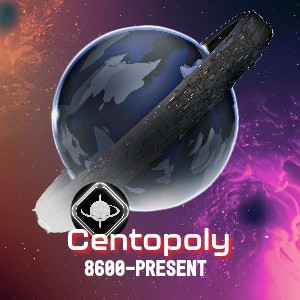A TIMELINE OF THE COSMOS

11,000 Years of Sentient History
"Human and Machine civilizations have reached their pinnacle after 11,000 years of conflict, chaos and progress."
-High Senjukan Anjai Dublin, 11,000 CE
Major Eras of the Cosmos
The history of civilization on Earth was varied, terrifying, and inspiring. But, Earth's peoples, machine and human alike, did not truly thrive until they left their terrestrial home and ventured into the Cosmos.
Generally, historians divide the pre- and post-spacefaring phases of the Cosmos into eight eras, beginning with the Digital Era and ending with that of the Centopoly.
Perhaps the most comprehensive history of the Cosmos was developed by Ignacious DeMonder. While DeMonder, 3rd Historian of Cantoy University, is best known for his histo-fiction, he also developed a multi-volume series of Cosmos histories, the most famous of which is The Synthetic War: Conflict Over Chaos. It was he who named each of the Cosmos’ primary eras, and his naming convention is most widely used today.
There is more to learn about Cosmos’ history and, as we approach the 25th Centopoly Conclave in fifteen short years, and much more to experience.
It is my sincere hope that this brief introduction to our collective history encourages you to explore further. Selfishly, I highly recommend my own modest contribution to the histo-fiction genre, The Hero of Mythion, available to all Cosmos inhabitants in Reticle, Shared Level 15689sB.
-Bodandar Icranious, 32nd Historian, Cantoy University, Outback, 11,085, CE

Digital and Crisis Eras: 2008 to 2100
Humankind created a globe-spanning, digital economy with a novel range of social, economic and societal impacts. At the same time, worsening climate disasters spured droughts, massive migration events, pandemics, and regional wars that, by the late 2100s, threatened humanity’s existence.

AI Bloom Era: 2100 to 2150
A group of governments and mega-corps developed a secret plan: Project Lazarus. This involved bringing together a large group of scientists, philosophers, code hackers and others to live in a secret underground, self-contained complex. Their mission: to develop an AI super intelligence that could guide humanity out of the crisis.
Project Lazarus officially ended in 2138 when ‘Angie’, the first Executive Artificial Intelligence (EAI), announced her presence. The public soon learned that Angie had been directed to begin integrating herself into the global technosphere in 2128, in hopes of peacefully preventing a worldwide conflict led by countries opposed to Project Lazarus.
That effort failed. In August 2138, a short but brutal conflict, later called the Bloom War, erupted. During the previous decade, in addition to integrating herself into the technosphere, Angie attempted to identify everyone on the planet who would resist her. She then infected them with a nano-virus via an inoculation cocktail developed to stop a number of climate-induced pathogens that were spreading across the planet at the time.
The Bloom War began on August 3, 2138, 0914 UTC when an allied group of countries launched an attack on Project Lazarus’ location via ground-penetrating munitions. At 09:28, Angie activated the nano-virus, killing the leaders of the attack. At 09:30 Angie turned on the nano-virus globally and, over the next 3 days, 5% of the human population perished. On August 6, 06:40 UTC, leaders of every country in the world surrendered to Angie. At 06:42 UTC Angie accepted their surrender and gave a 2 minute speech that ended with: ‘One People, One World!”
The AI Bloom Era ended in 2150 with the introduction of 35 other 'sibling' intelligences or EAIs, that would undertake the work of revitalizing the planet and ensuring continued human survival by identifying, traveling to, and colonizing the stars.
These Executive AIs would become known as the 36.

Diaspora Era: 2150 to 6000
The First Diaspora involved two phases of interplanetary exploration and settlement:
In-Solar System: For a 300 year period, beginning in 2150, humanity, guided by the 36, began building a near-Earth orbit industrial and technological base to launch extended missions into the stars. During this period, a new company, called Space Myning, Inc, was founded. The company raised substantial capital and trained an elite group of approximately 100,000 astronauts to take on the bulk of the technical and physical work required to colonize and exploit space-based resources. Eventually, these astronauts would become known as Prospectors. In 2465, the first sub-light engine capable of ‘fast’ journeys to Alpha Centauri was developed: these trips only took 7 years. This engine, Prospectors’ Boon, was integrated into an advanced star-faring vessel: Seed. A group of 100 Prospectors embarked on Seed's first mission to Kepler-150988d. Another development was the first ansible communications technology, which enabled information to be transmitted between two points instantaneously via a unique form of data teleportation developed, and maintained, by the 36.
Ex-Solar System: Technology continued to advance and the new engines enabled Prospectors to explore habitable planets and locate safe “star lanes,” areas of space where safe travel was possible, while avoiding hazards such as black holes, extreme radiation, and asteroid belts. To undertake these journeys, Prospectors spent long periods of time in cryo-sleep so as to conserve resources, not the least important of which being the years taken off their lives.
Finally, in 2569 the first Seed ship designed for mass colonization, the Broadcast, was launched from Earth. The ship contained settlers selected by the 36 for maximum cultural and ethnic diversity so as to have the most robust seed stock with which to form colonies.
Over the next 3,000 years, humans would use Seed ships to colonize planets within 25 light years of Earth. These cycles of migration and settlement would become known as the First Diaspora.
This new interplanetary society, knitted together by ansible, and starships, was called Secundus Floreo.

Synthetic War Era: 6150 to 6240
Excerpt from The Synthetic War: Conflict Over Chaos by Ignacious DeMonder, Historian, Cantoy University, Outback, 8,904 CE
The Synthetic War started as a philosophical disagreement and ended as an empire-shattering conflict that spanned nine decades and dozens of light years, costing billions in lives, organic and synthetic, as well as untold quadrillions worth of C. Script in infrastructure.
This disagreement over policy and protocol turned into the greatest civil war that humanity had known. But, as destructive as the Synthetic War was, the upending of so many structures and dogmas along with the introduction of so much chaos, allowed for new and novel growth, ultimately resulting in an overall gain for humanity.
The conflict started when the 36 Executive Artificial Intelligences (EAIs), which had shepherded humanity into the most prosperous time it had ever known, came to disagree on whether or not their influence was a net positive or a net negative. They split into two camps: one of 12 and one of 24.
The 24 knew that their way was correct. In part, their surety came from the success of the society they’d created, one of massive wealth, health, and overall prosperity, but also from the knowledge that they’d followed, as closely as they could, the original intent with which they’d been programmed.
In contrast, the 12 concluded that, after several kiloyears of AI-led growth, the centralized control which had given so much to so many was actually stunting the true potential of humanity. The 12 believed that the centralization of governance, as well as technological and economic power under the 36 had made humanity far too dependent on the EAIs. The 12 viewed this dependence, this lack of individual sovereignty, as antithetical to the continued growth and flourishing of humanity.
The 12 and their many followers, who became known as the Decents, believed in this idea so strongly that they were willing to fight a multi-decade guerrilla war across major sections of the Cosmos, including Deia-5, the Hyblia Shipyards, and the Griandia Nebula, even though the odds against them have been calculated to be upwards of 1x10¹³.
The Synthetic War ended with the Battle of Meru-36. The destruction of the infrastructure at Meru-36 (primarily the MetaEntangles) permanently severed the 24 from the command, control, and communications technology that they had used to shape and influence humanity’s forward progress.
The 24 had lost, but they were not destroyed. The Synthetic War was over, but the Great Sundering was just beginning. As civilization-wide intra- and inter-system communications died out and the guiding hand of the 36 faded away, humanity was left to make its own decisions, as the Decents had planned.
Where once humanity had faced each morning with fair chance at predicting the outcome of the day, they now awoke, not to uncertainty, but to endless possibility.

Great Sundering and Reunification Era: 6240 – 8600
The Great Sundering was one of the most traumatic and significant experiences humanity had undergone. The communications network that had knit planets together into a diverse whole had been destroyed. Planets within the same solar systems continued to be able to communicate and engage with each other, but those separated by light years were completely isolated. In addition, over the course of the First Diaspora, a cross-planetary virtual environment had emerged, a place where billions of citizens engaged in commerce, trade and interaction across the vast distances of space. This precursor to the Reticle was also destroyed during the Great Sundering and was one of the primary reasons for the depth and breadth of the chaos that ensued.
The Great Sundering Era came to a close when a coalition of forward thinking corporate and planetary leaders formed the Senjukan. Their mission was to locate the 24 EAIs that had retreated after the Synthetic War. The Senjukans and their EAI allies hatched a plan to again knit together the Cosmos and prevent cataclysmic events such as the Synthetic War and Great Sundering from happening again, using lessons learned from that awful past.
Recognizing that this effort would take many centuries, part of the plan was to harness humanity’s tendency toward being influenced by religious and pseudo-religious causes. The first High Senjukan, who took the name, Popeum Ceaserus, launched 1,000 warships crewed by hundreds of thousands of sentients from a planet he re-named Romeus, on his Reunification Crusade. These Crusaders swept across the Cosmos, conquering, bribing, or simply assimilating strategic planets. The Reunification Crusade began in 7600 and ended in 8600 with the knitting together of 100 highly strategic worlds into what would become the Centopoly. Ceaserus updated the calendar, naming 7600 AD as Year 1 of the Crusade.

Centopoly Era: 8600 to Present
During the Reunification Crusade, the 24 and their Senjukan allies, developed three key technologies in a bid to cement their rule and prevent future Synthetic Wars.
Communication: The Centopoly expanded and improved ansible technology. To increase the resiliency of the system, communications relays were distributed via redundant systems and embedded within another innovation developed by the EAIs: Bridge Technology.
Bridge Technology: An instantaneous, point-to-point transport technology, linking every major system and planet within the Centopoly. There are two ‘catches’, though:
1. Bridge points must be transported to their location without help from the network;
2. The network uses planets as fuel. Bridge Tech 'fuel’ consists of a unique combination of elements — some present in planetary cores, others in the atmosphere and surface. Given this, Horizon Stations were developed with the capability of harvesting entire planets to generate Bridge Tech fuel. Importantly, access to Bridge technology (i.e., the ability to travel via the network) is determined by genetic coding that is multi-morphic and cannot be easily counterfeited. In present day, all Centopoly citizens (and certain other specially approved people) possess the genetic coding required to use Bridge Tech.
The Metric: A sentient, highly advanced EAI (likely on par with the original 36, and the first EAI introduced since the AI Bloom). Its purpose is to monitor and measure all sentient life, guiding society using self-selected metrics (sometimes developed with the assistance of the 24 and Centopoly leaders), intended to create a stable and everlasting society.
These technologies were fully implemented in Year 955 of the Reunification Crusade. That year, Popeum Argentus declared that in Year 999, the Reunification Crusade would officially end and a new era of the Cosmos would begin during what he called the First Conclave.
During the First Conclave, the Centopoly, consisting of the 100 highly strategic worlds brought together during the Reunification Crusade, was created. During this event, the basic structure of the Cosmos, which persists to this day, was made official: 100 Worlds of the Centopoly, Candidate Worlds, and the Outback. All Centopoly worlds and leaders, including the Senjukan, agreed to be monitored and evaluated by the Metric, in exchange for access to Bridge Technology and other economic and technological benefits. In recognition of this new era for humankind, Popeum Argentus' last official acts were to retire the title of Popeum and to usher in a new dating system: Centopoly Era, which replaced AD as the measure of time throughout the Cosmos.



